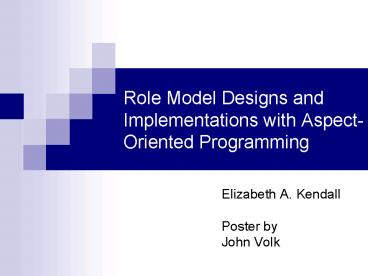Role Model Designs and Implementations with AspectOriented Programming - PowerPoint PPT Presentation
1 / 16
Title:
Role Model Designs and Implementations with AspectOriented Programming
Description:
Interface Bloat. The interface for all the Role objects must be contained in AgentInterface. ... for Agent is not bloated with methods for every possible ... – PowerPoint PPT presentation
Number of Views:60
Avg rating:3.0/5.0
Title: Role Model Designs and Implementations with AspectOriented Programming
1
Role Model Designs and Implementations with
Aspect-Oriented Programming
- Elizabeth A. Kendall
- Poster by
- John Volk
2
Paper Structure
- Describe the problem.
- while(solution insufficent)
- Describe a solution X to the problem.
- Decide whether solution X is sufficient.
- Describe benefits/drawbacks to solution X.
3
Bureaucracy Design Pattern (Problem)
- Describes interactions between various agents
acting in different roles. - Special case of a more general Pattern referred
to as a Role Model. - Other examples
- Supply Chain
- Negotiate for Services
- Contract Net
- Iterated Contract Net
- Auction
4
Bureaucracy Structure
- Five Different Roles
- Director
- Manages whole organization.
- Manager
- Report to the Director, and supervise their
Subordinates. - Subordinate
- Take orders from their Manager.
- Clerk
- Perform actual work requested by a Client.
- Client
- Request that work be done by the organization.
- Example
- Most obvious real-world example of this type of
system would be a client-server architecture in
which Clients make requests, and the Bureaucracy
funnels the request to the Clerk most capable of
performing the required task.
5
Bureaucracy Structure
6
Role Properties
- Abstractivity
- Roles can be organized into hierarchies
- Aggregation/Composition
- Roles can be composed of other roles.
- Dependency
- A role cannot exist without the object playing
the role. - Dynamicity
- Roles can be added/removed from an object during
its lifetime. - Identity
- The role and the object playing the role have the
same identity.
- Inheritance
- A role for a class is also a role for its
subclass. - Locality
- A role only has meaning inside of a role model.
- Multiplicity
- An object can play multiple roles at the same
time. - Visibility
- The visibility of an object can be restricted to
the interface of the role it is playing.
7
Traditional OO Solution
- Role Object Pattern
- An individual class is created for each role.
- Role objects are organized in a hierarchy.
- Core objects (agents) contain a collection of
role objects. - Role objects can be added/removed from the core
objects at runtime.
8
Role Object Pattern
9
Role Object Pattern Problems
- Object Schizophrenia
- This solution violates the Identity property,
because the agents behavior is distributed over
the Core object and its Roles. The agent and
its roles should be in the same object. - Interface Bloat
- The interface for all the Role objects must be
contained in AgentInterface.
10
Aspect-Oriented Solution
- Core behavior that is similar across all agents
is placed in an Agent class. - Roles are placed in various aspects that are
organized into a hierarchy. - Aspects have two main parts
- The introduce weave is the part of an aspect that
adds additional methods to an objects static
structure. - The advise weave is the part of an aspect that
modifies the dynamic (run-time) execution of an
objects methods.
11
Aspect Structure (Static and Dynamic)
12
Role Hierarchy
13
Clerk Code Example
14
Client Code Example
15
Aspect-Oriented Solution Benefits
- Object Schizophrenia
- Maintains the Identity role property, because
most role-specific code resides in the object
itself as a result of the introduce and advise
weaves. - Interface Maintenance
- The interface for Agent is not bloated with
methods for every possible role.
16
Questions
- What are some other potential uses of the
Bureaucracy pattern besides a client-server
architecture? - What patterns other than the Role Object pattern
might be used in creating an OO design for a
Bureacracy? - Theres no Director role in the role hierarchy
described for the aspect-oriented solution. How
might it be possible to create a Director agent
using the available roles?































